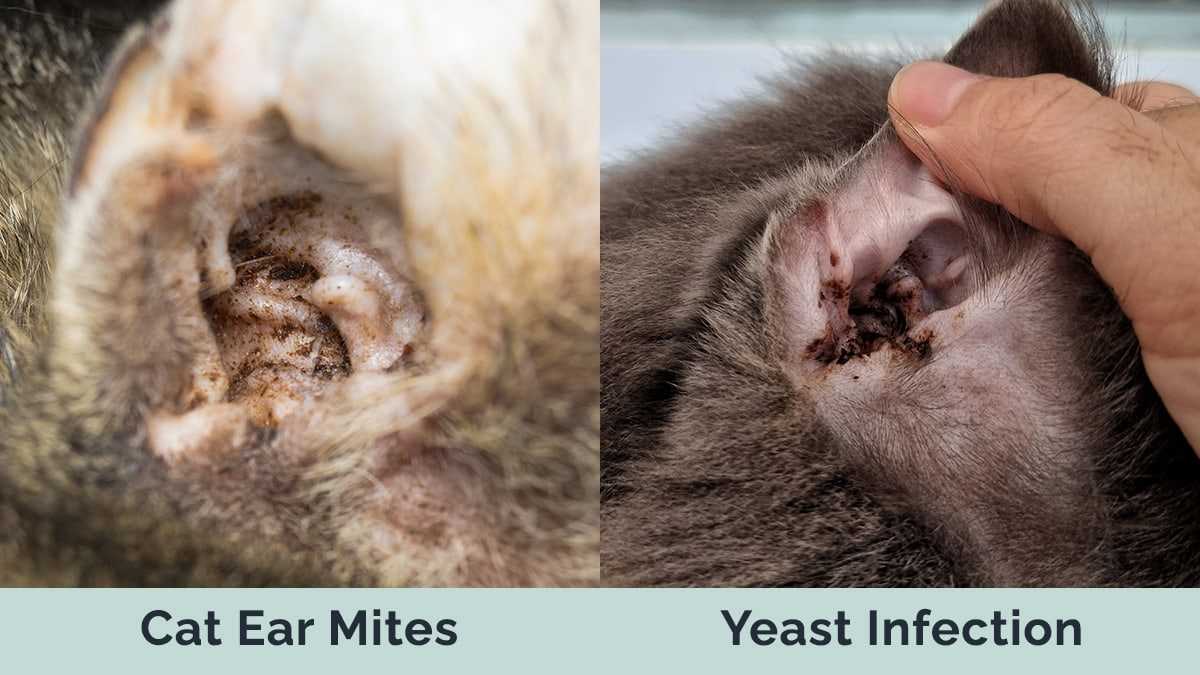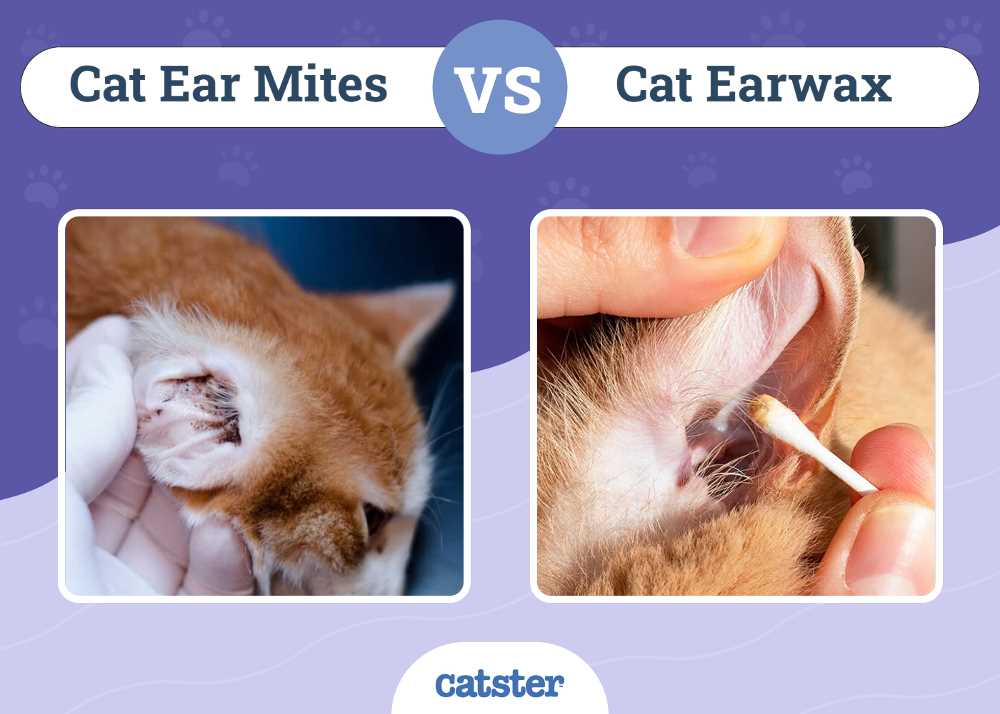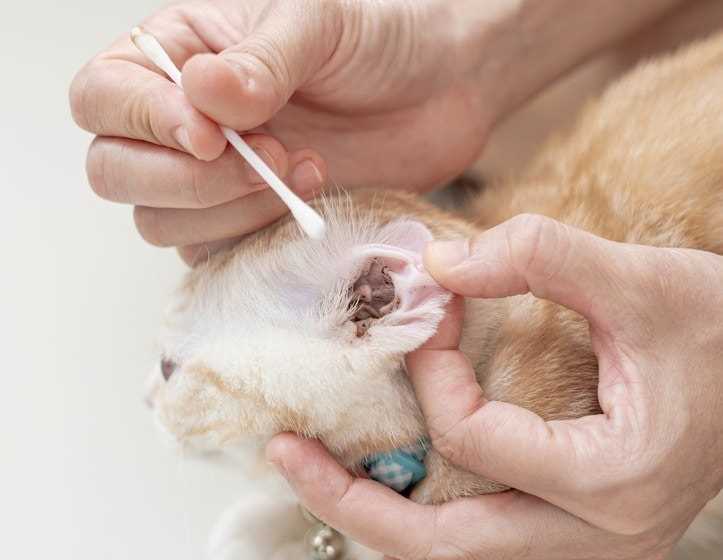Yes, an indoor feline can indeed encounter ear parasites. These tiny nuisances are not limited to those who roam outside, as they can hitch a ride on various items, including clothing and other pets.
Regular inspections of your pet’s ears are essential. Look for signs such as excessive scratching, head shaking, or dark discharge. If you notice any of these symptoms, consulting a veterinarian promptly is advisable. They can provide an accurate diagnosis and recommend effective treatments.
Preventative measures are key. Maintaining a clean living environment reduces the risk of infestation. Routine grooming and avoiding contact with other animals known to have these parasites can help keep your furry friend healthy. Always stay vigilant and proactive in your pet’s care.
Understanding the Risk of Parasites for Indoor Felines

Despite the common belief, indoor dwellers can indeed encounter tiny parasites that affect their ears. These nuisances are often transmitted through various means, making it important to remain vigilant.
Transmission Sources
- Contact with other animals: If your furry companion interacts with dogs or other pets that frequent outdoor spaces, there’s a risk of transmission.
- Human clothing: Individuals who visit environments with infected animals may inadvertently carry these unwanted pests back home.
- Second-hand items: Acquiring used bedding, toys, or carriers can also introduce these troublesome organisms.
Signs to Watch For

Observation is key. Look for:
- Frequent scratching around the head and ears.
- Dark, crumbly debris in the ears, resembling coffee grounds.
- Unusual head tilting or shaking, indicating discomfort.
If you notice any of these symptoms, it’s advisable to consult a veterinarian for a proper examination and treatment options.
Understanding How Ear Mites Are Transmitted to Indoor Cats
It’s a common misconception that only outdoor felines face the risk of these troublesome pests. I’ve learned that transmission can occur through various means, even within the confines of a home. Direct contact with another animal infected with these parasites is a primary method of spread. This includes visits from friends’ pets or even shared bedding.
Another factor is shared spaces. If a family member owns a dog that has encountered an infested animal, they can unknowingly bring these unwanted guests into the house. Additionally, items like toys, grooming tools, and blankets can harbor these organisms if they come into contact with infected animals.
Stress also plays a role. A change in environment, such as moving to a new home or new additions to the family, can weaken one’s immune system, making an individual more susceptible to an invasion. Maintaining a calm space can help keep these nuisances at bay.
Keeping a close watch on any signs of discomfort or unusual behavior is essential. Early detection of symptoms, such as scratching or shaking the head, can prevent further complications. Regular check-ups with a vet can ensure that any potential issues are addressed swiftly.
Staying informed and proactive is the best defense against these tiny invaders. Regular cleaning and monitoring can go a long way in maintaining a pest-free environment. It’s not just about living indoors; it’s about creating a safe and healthy space for everyone.
Signs and Symptoms of Ear Mite Infestation in Cats
Observe for excessive scratching around the ears or head area. If I’m shaking my head frequently, it could indicate irritation from unwanted visitors. A strong, dark discharge from the ear canal is another red flag; it often resembles coffee grounds.
Check for any signs of inflammation or redness in the ear flap. If there’s a foul odor coming from my ears, it might suggest a problem. Also, watch for changes in behavior–if I’m more irritable or withdrawn than usual, that could be a sign something isn’t right.
Monitor my grooming habits too. If I’m grooming my ears excessively, it may be due to discomfort. In some cases, you might notice hair loss around the ears from all that scratching. If you suspect I might be dealing with these issues, it’s wise to consult a vet for proper care.
Additionally, if I’m having trouble hearing or seem unusually sensitive to touch around my head, take that as an indication to investigate further. For any behavioral changes, such as inappropriate urination, you can refer to how to stop behavioral cat peeing for guidance.
Best Practices for Prevention and Treatment of Ear Mites
Regularly check ears for any signs of irritation or unusual discharge. Keeping the ear area clean helps prevent infestations. Use a gentle, veterinarian-approved ear cleaner to maintain hygiene.
Preventive Measures

Minimize contact with infested animals. If other pets are present, ensure they are treated and monitored. Vacuum frequently to eliminate potential eggs and debris from the environment.
Treatment Options
If an infestation occurs, consult a veterinarian for proper diagnosis and treatment. Prescription medications or topical solutions are effective options. Follow the vet’s instructions carefully and complete the full course of treatment to ensure success.
Yes, an indoor feline can indeed encounter ear parasites. These tiny nuisances are not limited to those who roam outside, as they can hitch a ride on various items, including clothing and other pets.
Regular inspections of your pet’s ears are essential. Look for signs such as excessive scratching, head shaking, or dark discharge. If you notice any of these symptoms, consulting a veterinarian promptly is advisable. They can provide an accurate diagnosis and recommend effective treatments.
Preventative measures are key. Maintaining a clean living environment reduces the risk of infestation. Routine grooming and avoiding contact with other animals known to have these parasites can help keep your furry friend healthy. Always stay vigilant and proactive in your pet’s care.
Understanding the Risk of Parasites for Indoor Felines

Despite the common belief, indoor dwellers can indeed encounter tiny parasites that affect their ears. These nuisances are often transmitted through various means, making it important to remain vigilant.
Transmission Sources
- Contact with other animals: If your furry companion interacts with dogs or other pets that frequent outdoor spaces, there’s a risk of transmission.
- Human clothing: Individuals who visit environments with infected animals may inadvertently carry these unwanted pests back home.
- Second-hand items: Acquiring used bedding, toys, or carriers can also introduce these troublesome organisms.
Signs to Watch For

Observation is key. Look for:
- Frequent scratching around the head and ears.
- Dark, crumbly debris in the ears, resembling coffee grounds.
- Unusual head tilting or shaking, indicating discomfort.
If you notice any of these symptoms, it’s advisable to consult a veterinarian for a proper examination and treatment options.
Understanding How Ear Mites Are Transmitted to Indoor Cats
It’s a common misconception that only outdoor felines face the risk of these troublesome pests. I’ve learned that transmission can occur through various means, even within the confines of a home. Direct contact with another animal infected with these parasites is a primary method of spread. This includes visits from friends’ pets or even shared bedding.
Another factor is shared spaces. If a family member owns a dog that has encountered an infested animal, they can unknowingly bring these unwanted guests into the house. Additionally, items like toys, grooming tools, and blankets can harbor these organisms if they come into contact with infected animals.
Stress also plays a role. A change in environment, such as moving to a new home or new additions to the family, can weaken one’s immune system, making an individual more susceptible to an invasion. Maintaining a calm space can help keep these nuisances at bay.
Keeping a close watch on any signs of discomfort or unusual behavior is essential. Early detection of symptoms, such as scratching or shaking the head, can prevent further complications. Regular check-ups with a vet can ensure that any potential issues are addressed swiftly.
Staying informed and proactive is the best defense against these tiny invaders. Regular cleaning and monitoring can go a long way in maintaining a pest-free environment. It’s not just about living indoors; it’s about creating a safe and healthy space for everyone.
Signs and Symptoms of Ear Mite Infestation in Cats
Observe for excessive scratching around the ears or head area. If I’m shaking my head frequently, it could indicate irritation from unwanted visitors. A strong, dark discharge from the ear canal is another red flag; it often resembles coffee grounds.
Check for any signs of inflammation or redness in the ear flap. If there’s a foul odor coming from my ears, it might suggest a problem. Also, watch for changes in behavior–if I’m more irritable or withdrawn than usual, that could be a sign something isn’t right.
Monitor my grooming habits too. If I’m grooming my ears excessively, it may be due to discomfort. In some cases, you might notice hair loss around the ears from all that scratching. If you suspect I might be dealing with these issues, it’s wise to consult a vet for proper care.
Additionally, if I’m having trouble hearing or seem unusually sensitive to touch around my head, take that as an indication to investigate further. For any behavioral changes, such as inappropriate urination, you can refer to how to stop behavioral cat peeing for guidance.
Best Practices for Prevention and Treatment of Ear Mites
Regularly check ears for any signs of irritation or unusual discharge. Keeping the ear area clean helps prevent infestations. Use a gentle, veterinarian-approved ear cleaner to maintain hygiene.
Preventive Measures

Minimize contact with infested animals. If other pets are present, ensure they are treated and monitored. Vacuum frequently to eliminate potential eggs and debris from the environment.
Treatment Options
If an infestation occurs, consult a veterinarian for proper diagnosis and treatment. Prescription medications or topical solutions are effective options. Follow the vet’s instructions carefully and complete the full course of treatment to ensure success.
Yes, an indoor feline can indeed encounter ear parasites. These tiny nuisances are not limited to those who roam outside, as they can hitch a ride on various items, including clothing and other pets.
Regular inspections of your pet’s ears are essential. Look for signs such as excessive scratching, head shaking, or dark discharge. If you notice any of these symptoms, consulting a veterinarian promptly is advisable. They can provide an accurate diagnosis and recommend effective treatments.
Preventative measures are key. Maintaining a clean living environment reduces the risk of infestation. Routine grooming and avoiding contact with other animals known to have these parasites can help keep your furry friend healthy. Always stay vigilant and proactive in your pet’s care.
Understanding the Risk of Parasites for Indoor Felines

Despite the common belief, indoor dwellers can indeed encounter tiny parasites that affect their ears. These nuisances are often transmitted through various means, making it important to remain vigilant.
Transmission Sources
- Contact with other animals: If your furry companion interacts with dogs or other pets that frequent outdoor spaces, there’s a risk of transmission.
- Human clothing: Individuals who visit environments with infected animals may inadvertently carry these unwanted pests back home.
- Second-hand items: Acquiring used bedding, toys, or carriers can also introduce these troublesome organisms.
Signs to Watch For

Observation is key. Look for:
- Frequent scratching around the head and ears.
- Dark, crumbly debris in the ears, resembling coffee grounds.
- Unusual head tilting or shaking, indicating discomfort.
If you notice any of these symptoms, it’s advisable to consult a veterinarian for a proper examination and treatment options.
Understanding How Ear Mites Are Transmitted to Indoor Cats
It’s a common misconception that only outdoor felines face the risk of these troublesome pests. I’ve learned that transmission can occur through various means, even within the confines of a home. Direct contact with another animal infected with these parasites is a primary method of spread. This includes visits from friends’ pets or even shared bedding.
Another factor is shared spaces. If a family member owns a dog that has encountered an infested animal, they can unknowingly bring these unwanted guests into the house. Additionally, items like toys, grooming tools, and blankets can harbor these organisms if they come into contact with infected animals.
Stress also plays a role. A change in environment, such as moving to a new home or new additions to the family, can weaken one’s immune system, making an individual more susceptible to an invasion. Maintaining a calm space can help keep these nuisances at bay.
Keeping a close watch on any signs of discomfort or unusual behavior is essential. Early detection of symptoms, such as scratching or shaking the head, can prevent further complications. Regular check-ups with a vet can ensure that any potential issues are addressed swiftly.
Staying informed and proactive is the best defense against these tiny invaders. Regular cleaning and monitoring can go a long way in maintaining a pest-free environment. It’s not just about living indoors; it’s about creating a safe and healthy space for everyone.
Signs and Symptoms of Ear Mite Infestation in Cats
Observe for excessive scratching around the ears or head area. If I’m shaking my head frequently, it could indicate irritation from unwanted visitors. A strong, dark discharge from the ear canal is another red flag; it often resembles coffee grounds.
Check for any signs of inflammation or redness in the ear flap. If there’s a foul odor coming from my ears, it might suggest a problem. Also, watch for changes in behavior–if I’m more irritable or withdrawn than usual, that could be a sign something isn’t right.
Monitor my grooming habits too. If I’m grooming my ears excessively, it may be due to discomfort. In some cases, you might notice hair loss around the ears from all that scratching. If you suspect I might be dealing with these issues, it’s wise to consult a vet for proper care.
Additionally, if I’m having trouble hearing or seem unusually sensitive to touch around my head, take that as an indication to investigate further. For any behavioral changes, such as inappropriate urination, you can refer to how to stop behavioral cat peeing for guidance.
Best Practices for Prevention and Treatment of Ear Mites
Regularly check ears for any signs of irritation or unusual discharge. Keeping the ear area clean helps prevent infestations. Use a gentle, veterinarian-approved ear cleaner to maintain hygiene.
Preventive Measures

Minimize contact with infested animals. If other pets are present, ensure they are treated and monitored. Vacuum frequently to eliminate potential eggs and debris from the environment.
Treatment Options
If an infestation occurs, consult a veterinarian for proper diagnosis and treatment. Prescription medications or topical solutions are effective options. Follow the vet’s instructions carefully and complete the full course of treatment to ensure success.






